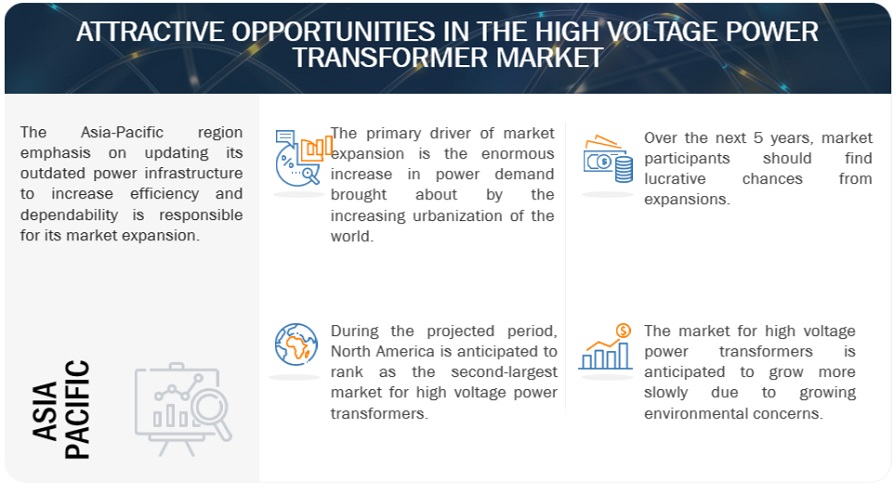The global High Voltage Power Transformer Market in terms of revenue was estimated to be worth $9.1 billion in 2024 and is poised to reach $12.3 billion by 2029, growing at a CAGR of 6.3% from 2024 to 2029 according to a new report by MarketsandMarkets™.
This growth is primarily driven by the need to strengthen power distribution networks to keep up with the rising global demand for electricity. Furthermore, the market stands to gain from the increasing capacity of renewable energy sources and substantial investments in industrial production, both of which are expected to boost the demand for High voltage power transformers. Another key factor contributing to this expansion is the growing adoption of high-voltage direct current systems, which is expected to further accelerate market growth during the forecast period.
Download PDF Brochure: https://www.marketsandmarkets.com/pdfdownloadNew.asp?id=54126096
The increasing demand for electricity is driving the high voltage power transformer market. The growing need for grid expansion and upgrades to cater to the rising demand for electricity includes expanding existing grids and reinforcing transmission lines for higher capacity. This leads to demand for more transformers at substations and along transmission lines. Additionally, the modernization of aging grids with upgraded infrastructure increases the demand for transformers with advanced features, such as higher voltage and current handling capabilities, smart grid features, and efficient load management for two-way communication. The shift toward renewable energy sources, such as solar and wind power, presents a unique challenge for grid integration. These sources are variable and non-dispatchable, so they rely on weather conditions for generation. High voltage power transformers are crucial in integrating renewable energy sources into the grid by stepping up the voltage generated by solar and wind farms to match the transmission grid voltage. They also provide grid stability by managing fluctuations in power generation from these sources. The demand for transformers is observed across regions. Developed economies focus on grid modernization for improved efficiency and reliability. Developing economies undertake massive grid expansion projects to accommodate urbanization and cater to remote areas requiring transformers.

The oil immersed segment is expected to continue dominating the High Voltage Power Transformer Market share due to several inherent advantages that oil cooling offers over other methods like air cooling. Oil as a coolant is more effective in dissipating heat from the transformer core and windings because of its superior thermal conductivity and higher heat capacity. This enables oil immersed transformers to handle higher power capacities and operate at a lower temperature, enhancing their efficiency and lifespan. Furthermore, oil immersion helps prevent oxidation of the core and coil, thereby reducing maintenance needs and improving reliability. The fluid also serves as an excellent insulator, significantly reducing the risk of electrical faults within the transformer. Despite concerns about potential environmental impacts, such as oil leaks, advancements in containment and bio-based oils are addressing these challenges, making oil immersed transformers a preferred choice for heavy-duty applications in industrial and utility settings where high power output and reliability are critical. This enduring preference secures their majority stake in the market.
Request Sample Pages: https://www.marketsandmarkets.com/requestsampleNew.asp?id=54126096
Asia Pacific to emerge as the largest High Voltage Power Transformer Market.
Asia Pacific is expected to emerge as the largest market for high voltage power transformers, driven by several convergent factors that are shaping its energy landscape. The primary driver is the expansive urbanization and industrialization across major economies such as China, India, and Southeast Asia. These countries are experiencing significant growth in their manufacturing sectors and widespread construction of new infrastructure, which necessitates a robust and reliable power supply, thereby increasing the demand for high voltage high voltage power transformers. Moreover, governments in the Asia-Pacific are heavily investing in enhancing their national grid infrastructures to support economic growth and improve the quality of life for their growing populations. According to a recent BloombergNEF report, China accounted for nearly half of all global low-carbon spending. In 2022, the country invested USD 546 billion in solar and wind energy, as well as electric vehicles and batteries. India plans to invest USD 34.2 billion by 2030 in an interstate transmission network (ISTS) to evacuate renewable energy, according to K Sreekant, Chairman and Managing Director of government owned Powergrid Corporation of India (PGCIL). According to data from GlobalData, Energy Monitor’s parent business, China invests more in transmission grids than any other country combined. In 2022, China invested USD 166 billion in its transmission infrastructure, while other countries contributed USD 118 billion. Investments in infrastructure updates are driven by the country’s aging power infrastructure. All these investments will likely drive the high voltage high voltage High Voltage Power Transformer Market in the Asia Pacific region. This has led to a surge in demand for advanced high voltage high voltage power transformers that can handle the variable outputs of renewable energy sources such as wind and solar. Additionally, the region is characterized by a strong push towards rural electrification, especially in countries with significant rural populations. Programs aimed at extending the electrical grid to remote areas are crucial in increasing the penetration of electricity to underserved regions, further driving the demand for high voltage high voltage power transformers.
Key players in the global High Voltage Power Transformer Market include Hitachi Energy (Japan), Siemens Energy (Germany), Schneider Electric (France), Toshiba Energy System & Solution Corporation (Japan), and General Electric (US).


